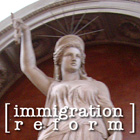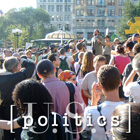
|
BUSH SIGNS BORDER FENCE LAW, ESTABLISHING PERMANENT BARRIER ALONG 700 MILES OF MEXICO-US BORDER 27 October 2006 Before his party reached any agreement on proposed immigration policy reform legislation, Pres. George W. Bush yesterday signed a new law imposing harsh restrictions at US border crossings, establishing 700 miles of fencing to be patrolled by military, border guards, dogs, and drones. The Washington Post reports "The bill stipulates that the Department of Homeland Security is responsible for gaining control of the border within 18 months, using unmanned aerial vehicles, ground-based sensors, satellites, radar and cameras to prevent all unlawful U.S. entries." The report goes on to add "Congress approved $1.2 billion in a separate homeland security spending bill to bankroll the fence, though critics say this is $4.8 billion less than what’s likely needed to get it built." Costly, and according to critics politically motivated, the legislation is designed to provide a method of ensuring more organized registration and processing of border crossings. The plan has been opposed by the Mexican government, as well as experts and intellectuals from Mexico, several Latin American governments, and the governor of Texas, Republican Rick Perry. Governor Perry has said he believes the border needs to be made more open, to facilitate trade and travel and to reduce the threat caused by increasingly violent smuggling sindicates. The border issue is one of economic and political coherence as well as personal risk and wellbeing. A "closed" border, where crossings are subject to strict controls, can have its adverse effects, and has left the US-Mexico border rife with smuggling rings and dangerous human-trafficking networks. According to WorkPermit.com, "From Oct. 1, 2005, to Sept. 15 of this year, 426 people died while illegally crossing the border, and the Colegio de la Frontera Norte says the death toll since 1994 is about 3,700." It is unclear whether a security wall will reduce the number of people crossing the border, or reduce the rate of mortality in the journey. In 1994, a program known as "Operation Gatekeeper" put chain-link fence and corrugated metal walls along sections of the border, but traffic was merely redirected and the number of crossings in 1995 and 2005 is estimated to be virtually equal. One major risk is that a fully fortified border may provoke higher-stakes smuggling operations, and put more people at risk of losing their lives, as they are forced into more and more remote desert wilderness, far from population centers or emergency assistance of any kind. Critics say it will also cut off communities which have contact both socially and economically on either side of the border, and could reduce economic activity in certain areas, provoking more attempts to reach the northern side of the border. Critics have also raised the question as to whether there is any real security benefit to recent legislation to secure the border: The homeland security bill signed in early October includes funding for a fortified border, but does not sufficiently address the goals of reducing risk of attack against industrial infrastructure or achieving effective but unobtrusive port security. Rep. Ed Markey, a senior member of the House homeland security committee has said "There are nightclubs in New York City that are harder to get into than some of our chemical plants".
BACKGROUND/DE TRASFONDO: Anoche, George W. Bush presentó desde su despacho en la Casa Blanca, un plan de cinco puntos claves para una "reforma comprensiva" de la política migratoria de Estados Unidos. El plan incluye despachar 6 mil soldados de la Guardia Nacional a la frontera con México y un carnet biométrico para los inmigrantes, pero también moderó su retórica, recordando que "todo ser humano tiene valor y dignidad, a pesar del estatus de sus papeles de ciudadanía." [Texto completo] NEW ROUND OF MASSIVE PRO-IMMIGRANT DEMONSTRATIONS Peaceful rallies in more than 60 US cities took place yesterday, to protest against House Republicans' plans to classify all undocumented immigrants as felons, to build fortified wall between US, Mexico. Tens of thousands gathered in major cities, carrying banners reading "We are America" and waving American flags and flags of their countries of origin. [Full Story] IMMIGRATION REFORM COULD EASE HARDSHIP FOR MILLIONS In recent weeks, the United States has seen the streets of major cities flooded with protesters, demanding more humane immigration reform than that offered by the House of Representatives. The bill currently before the Senate could offer such a solution, and would provide an opportunity for millions more people to become US citizens. [Full Story] |
||||||||||||||||
|
|||||||||||||||||









